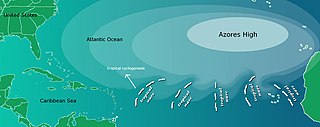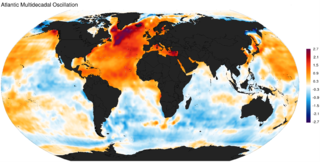Related Research Articles

El Niño is the warm phase of the El Niño–Southern Oscillation (ENSO) and is associated with a band of warm ocean water that develops in the central and east-central equatorial Pacific, including the area off the Pacific coast of South America. The ENSO is the cycle of warm and cold sea surface temperature (SST) of the tropical central and eastern Pacific Ocean.

Jet streams are fast flowing, narrow, meandering air currents in the atmospheres of some planets, including Earth. On Earth, the main jet streams are located near the altitude of the tropopause and are westerly winds. Jet streams may start, stop, split into two or more parts, combine into one stream, or flow in various directions including opposite to the direction of the remainder of the jet.

La Niña is an oceanic and atmospheric phenomenon that is the colder counterpart of El Niño, as part of the broader El Niño–Southern Oscillation (ENSO) climate pattern. The name La Niña originates from Spanish for "the girl", by analogy to El Niño, meaning "the boy". In the past, it was also called an anti-El Niño and El Viejo, meaning "the old man."

Climatology or climate science is the scientific study of Earth's climate, typically defined as weather conditions averaged over a period of at least 30 years. This modern field of study is regarded as a branch of the atmospheric sciences and a subfield of physical geography, which is one of the Earth sciences. Climatology now includes aspects of oceanography and biogeochemistry.

El Niño–Southern Oscillation (ENSO) is an irregular periodic variation in winds and sea surface temperatures over the tropical eastern Pacific Ocean, affecting the climate of much of the tropics and subtropics. The warming phase of the sea temperature is known as El Niño and the cooling phase as La Niña. The Southern Oscillation is the accompanying atmospheric component, coupled with the sea temperature change: El Niño is accompanied by high air surface pressure in the tropical western Pacific and La Niña with low air surface pressure there. The two periods last several months each and typically occur every few years with varying intensity per period.
The North Atlantic Oscillation (NAO) is a weather phenomenon over the North Atlantic Ocean of fluctuations in the difference of atmospheric pressure at sea level (SLP) between the Icelandic Low and the Azores High. Through fluctuations in the strength of the Icelandic Low and the Azores High, it controls the strength and direction of westerly winds and location of storm tracks across the North Atlantic.
The Tropical Ocean Global Atmosphere program (TOGA) was a ten-year study (1985-1994) of the World Climate Research Programme (WCRP) aimed specifically at the prediction of climate phenomena on time scales of months to years.
Warren White is a professor emeritus, and a former Research Oceanographer at the Marine Biological Research Division at Scripps Institution of Oceanography at UC San Diego.

The Arctic oscillation (AO) or Northern Annular Mode/Northern Hemisphere Annular Mode (NAM) is a weather phenomenon at the Arctic pole north of 20 degrees latitude. It is an important mode of climate variability for the Northern Hemisphere. The southern hemisphere analogue is called the Antarctic oscillation or Southern Annular Mode (SAM). The index varies over time with no particular periodicity, and is characterized by non-seasonal sea-level pressure anomalies of one sign in the Arctic, balanced by anomalies of opposite sign centered at about 37–45° N.

The Pacific decadal oscillation (PDO) is a robust, recurring pattern of ocean-atmosphere climate variability centered over the mid-latitude Pacific basin. The PDO is detected as warm or cool surface waters in the Pacific Ocean, north of 20°N. Over the past century, the amplitude of this climate pattern has varied irregularly at interannual-to-interdecadal time scales. There is evidence of reversals in the prevailing polarity of the oscillation occurring around 1925, 1947, and 1977; the last two reversals corresponded with dramatic shifts in salmon production regimes in the North Pacific Ocean. This climate pattern also affects coastal sea and continental surface air temperatures from Alaska to California.

The Madden–Julian oscillation (MJO) is the largest element of the intraseasonal variability in the tropical atmosphere. It was discovered in 1971 by Roland Madden and Paul Julian of the American National Center for Atmospheric Research (NCAR). It is a large-scale coupling between atmospheric circulation and tropical deep atmospheric convection. Unlike a standing pattern like the El Niño–Southern Oscillation (ENSO), the Madden–Julian oscillation is a traveling pattern that propagates eastward, at approximately 4 to 8 m/s, through the atmosphere above the warm parts of the Indian and Pacific oceans. This overall circulation pattern manifests itself most clearly as anomalous rainfall.

Tropical cyclogenesis is the development and strengthening of a tropical cyclone in the atmosphere. The mechanisms through which tropical cyclogenesis occurs are distinctly different from those through which temperate cyclogenesis occurs. Tropical cyclogenesis involves the development of a warm-core cyclone, due to significant convection in a favorable atmospheric environment.

The Azores High also known as North Atlantic (Subtropical) High/Anticyclone or the Bermuda-Azores High, is a large subtropical semi-permanent centre of high atmospheric pressure typically found south of the Azores in the Atlantic Ocean, at the Horse latitudes. It forms one pole of the North Atlantic oscillation, the other being the Icelandic Low. The system influences the weather and climatic patterns of vast areas of North Africa, Western Asia, Southern Europe, and to a lesser extent, eastern North America. The aridity of the Sahara Desert and the summer drought of the Mediterranean Basin is due to the large-scale subsidence and sinking motion of air in the system. In its summer position, the high is centered near Bermuda, and creates a southwest flow of warm tropical air toward the East Coast of the United States. In summer, the Azores-Bermuda High is strongest. The central pressure hovers around 1024 mbar (hPa).

The Atlantic Multidecadal Oscillation (AMO), also known as Atlantic Multidecadal Variability (AMV), is the theorized variability of the sea surface temperature (SST) of the North Atlantic Ocean on the timescale of several decades.
The Atlantic Equatorial Mode or Atlantic Niño is a quasiperiodic interannual climate pattern of the equatorial Atlantic Ocean. It is the dominant mode of year-to-year variability that results in alternating warming and cooling episodes of sea surface temperatures accompanied by changes in atmospheric circulation. The term Atlantic Niño comes from its close similarity with the El Niño-Southern Oscillation (ENSO) that dominates the tropical Pacific basin. For this reason, the Atlantic Niño is often called the little brother of El Niño. The Atlantic Niño usually appears in northern summer, and is not the same as the Atlantic Meridional (Interhemispheric) Mode that consists of a north-south dipole across the equator and operates more during northern spring. The equatorial warming and cooling events associated with the Atlantic Niño are known to be strongly related to rainfall variability over the surrounding continents, especially in West African countries bordering the Gulf of Guinea. Therefore, understanding of the Atlantic Niño has important implications for climate prediction in those regions. Although the Atlantic Niño is an intrinsic mode to the equatorial Atlantic, there may be a tenuous causal relationship between ENSO and the Atlantic Niño in some circumstances.
The Tropical Atlantic SST Dipole refers to a cross-equatorial sea surface temperature (SST) pattern that appears dominant on decadal timescales. It has a period of about 12 years, with the SST anomalies manifesting their most pronounced features around 10–15 degrees of latitude off of the Equator. It is also referred to as the interhemispheric SST gradient or the Meridional Atlantic mode.
The Tropical Atlantic Variability (TAV) is influenced by internal interaction and external effects. TAV can be discussed in different time scales: seasonal and interannual. tav can be discussed in different time scales:seasonal and interannual.and external effects.

Pacific Meridional Mode (PMM) is a climate mode in the North Pacific. In its positive state, it is characterized by the coupling of weaker trade winds in the northeast Pacific Ocean between Hawaii and Baja California with decreased evaporation over the ocean, thus increasing sea surface temperatures (SST); and the reverse during its negative state. This coupling develops during the winter months and spreads southwestward towards the equator and the central and western Pacific during spring, until it reaches the Intertropical Convergence Zone (ITCZ), which tends to shift north in response to a positive PMM.
Ocean dynamical thermostat is a physical mechanism through which changes in the mean radiative forcing influence the gradients of sea surface temperatures in the Pacific Ocean and the strength of the Walker circulation. Increased radiative forcing (warming) is more effective in the western Pacific than in the eastern where the upwelling of cold water masses damps the temperature change. This increases the east-west temperature gradient and strengthens the Walker circulation. Decreased radiative forcing (cooling) has the opposite effect.
Rodwell–Hoskins mechanism is a hypothesis about a climatic teleconnection between the Indian/Asian summer monsoon and the climate of the Mediterranean. It stipulates that ascending air in the monsoon region induces atmospheric circulation features named Rossby waves that expand westward and interact with the mean westerly winds of the midlatitudes, eventually inducing descent of the air. Descending air warms and its humidity decreases, thus resulting in a drier climate during the summer months. The interaction of this atmospheric flow with the topography such as the Atlas and Zagros mountains further modifies the effect.
References
- ↑ Lamb, Peter J.; Peppler, Randy A. (1987-10-01). "North Atlantic Oscillation: Concept and an Application". Bulletin of the American Meteorological Society. 68 (10): 1218–1225. doi:10.1175/1520-0477(1987)068<1218:NAOCAA>2.0.CO;2. ISSN 1520-0477.
- ↑ Wallace, John M.; Gutzler, David S. (1981). "Teleconnections in the Geopotential Height Field during the Northern Hemisphere Winter". Monthly Weather Review. 109 (4): 784. Bibcode:1981MWRv..109..784W. doi: 10.1175/1520-0493(1981)109<0784:TITGHF>2.0.CO;2 .
- ↑ Hoskins, Brian J.; Karoly, David J. (1981). "The Steady Linear Response of a Spherical Atmosphere to Thermal and Orographic Forcing". Journal of the Atmospheric Sciences. 38 (6): 1179. Bibcode:1981JAtS...38.1179H. doi: 10.1175/1520-0469(1981)038<1179:TSLROA>2.0.CO;2 .
- ↑ Trenberth, Kevin E.; Branstator, Grant W.; Karoly, David; Kumar, Arun; Lau, Ngar-Cheung; Ropelewski, Chester (1998). "Progress during TOGA in understanding and modeling global teleconnections associated with tropical sea surface temperatures". Journal of Geophysical Research. 103 (C7): 14291–14324. Bibcode:1998JGR...10314291T. doi: 10.1029/97JC01444 .
- ↑ Gill, A. E. (1980). "Some simple solutions for heat-induced tropical circulation". Quarterly Journal of the Royal Meteorological Society. 106 (449): 447–462. Bibcode:1980QJRMS.106..447G. doi:10.1002/qj.49710644905.
- ↑ Simmons, A. J.; Wallace, J. M.; Branstator, G. W. (1983). "Barotropic Wave Propagation and Instability, and Atmospheric Teleconnection Patterns". Journal of the Atmospheric Sciences. 40 (6): 1363. Bibcode:1983JAtS...40.1363S. doi: 10.1175/1520-0469(1983)040<1363:BWPAIA>2.0.CO;2 .
- ↑ Held, Isaac M.; Ting, Mingfang; Wang, Hailan (2002). "Northern Winter Stationary Waves: Theory and Modeling". Journal of Climate. 15 (16): 2125. Bibcode:2002JCli...15.2125H. CiteSeerX 10.1.1.140.5658 . doi:10.1175/1520-0442(2002)015<2125:NWSWTA>2.0.CO;2.
- ↑ Seager, Richard; Harnik, Nili; Kushnir, Yochanan; Robinson, Walter; Miller, Jennifer (2003). "Mechanisms of Hemispherically Symmetric Climate Variability*". Journal of Climate. 16 (18): 2960. Bibcode:2003JCli...16.2960S. doi:10.1175/1520-0442(2003)016<2960:MOHSCV>2.0.CO;2.
- ↑ Seager, R.; Harnik, N.; Robinson, W. A.; Kushnir, Y.; Ting, M.; Huang, H.-P.; Velez, J. (2005). "Mechanisms of ENSO-forcing of hemispherically symmetric precipitation variability". Quarterly Journal of the Royal Meteorological Society. 131 (608): 1501. Bibcode:2005QJRMS.131.1501S. doi:10.1256/qj.04.96.
- ↑ Ramadan, H. H.; Ramamurthy, A. S.; Beighley, R. E. (2011). "Inter-annual temperature and precipitation variations over the Litani Basin in response to atmospheric circulation patterns". Theoretical and Applied Climatology. 108 (3–4): 563. Bibcode:2012ThApC.108..563R. doi:10.1007/s00704-011-0554-1.
- ↑ Chen, Dake; Cane, Mark A.; Kaplan, Alexey; Zebiak, Stephen E.; Huang, Daji (2004). "Predictability of El Niño over the past 148 years". Nature. 428 (6984): 733–6. Bibcode:2004Natur.428..733C. doi:10.1038/nature02439. PMID 15085127.
- ↑ IRI Seasonal Climate Forecasts
- ↑ Wanner, Heinz; Brönnimann, Stefan; Casty, Carlo; Gyalistras, Dimitrios; Luterbacher, Jürg; Schmutz, Christoph; Stephenson, David B.; Xoplaki, Eleni (2001-07-01). "North Atlantic Oscillation – Concepts And Studies". Surveys in Geophysics. 22 (4): 321–381. doi:10.1023/A:1014217317898. ISSN 1573-0956.
- ↑ "North Atlantic Oscillation (NAO) | National Centers for Environmental Information (NCEI)". www.ncei.noaa.gov. Retrieved 2023-04-05.